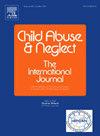Collaboration between nurse home visitors and child welfare predicts participant attrition in home visiting programs
IF 3.4
2区 心理学
Q1 FAMILY STUDIES
引用次数: 0
Abstract
Background
Evidence-based home visiting programs like Nurse-Family Partnership (NFP) improve the health of families experiencing social and economic adversities. Cross-sector collaboration is thought to influence the ability of these programs to improve maternal-child health and prevent child maltreatment.
Objective
To assess the association between NFP and Child Protective Services (CPS) collaboration and participant attrition in NFP.
Participants and setting
We included NFP participants (n = 95,397) in the United States with their first visit between January 1, 2015 and December 31, 2021.
Methods
We used Cox Proportional Hazards models to estimate adjusted hazard (dropout) ratios associated with NFP-CPS collaboration. We operationalized collaboration as two domains: relational coordination measured by the 7-item Relational Coordination Scale and structural integration measured by 4 adapted items from the Interagency Collaboration Activities Scale on shared resources.
Results
We found no statistically significant association between participant attrition and relational coordination, while structural integration was negatively associated with attrition (HR:0.986 [0.981–0.992]. Among NFP families referred to CPS by their NFP nurse (n = 2968), integration was also negatively associated with attrition (HR:0.955 [0.921–0.992]). In stratified models, integration was negatively associated with attrition for participants receiving NFP through government agencies (HR:0.969 [0.962–0.0.976]) and health care entities (HR:0.980, [0.965–0.995]), but not for community-based organizations. Coordination was positively associated with attrition for participants receiving NFP out of health care entities (HR:1.067 [1.029–1.111]).
Conclusions
Our results highlight associations between provider collaboration and participant attrition in NFP. What structures should be enacted to facilitate collaboration for families with multiple adversities needs continued research and innovation.
护士家访和儿童福利之间的合作预测了家访计划中参与者的流失
护士家庭合作(NFP)等基于证据的家访项目改善了经历社会和经济困境的家庭的健康状况。人们认为,跨部门合作会影响这些方案改善妇幼保健和防止虐待儿童的能力。目的探讨儿童保护服务与儿童保护服务合作的关系以及儿童保护服务中参与者的流失。参与者和环境我们纳入了2015年1月1日至2021年12月31日期间首次访问美国的NFP参与者(n = 95,397)。方法采用Cox比例风险模型估计与NFP-CPS合作相关的调整风险(退出)比率。我们将协作运作为两个领域:由7项关系协调量表测量的关系协调和由共享资源的跨机构协作活动量表中的4个调整项目测量的结构整合。结果参与者磨耗与关系协调无显著相关,结构整合与磨耗呈显著负相关(HR:0.986[0.981-0.992])。在由NFP护士转介到CPS的NFP家庭中(n = 2968),整合与磨耗也呈负相关(HR:0.955[0.921-0.992])。在分层模型中,通过政府机构(HR:0.969[0.962-0.0.976])和卫生保健机构(HR:0.980,[0.965-0.995])接受NFP的参与者的整合与减员呈负相关,而社区组织的参与者则没有。在医疗机构外接受NFP的参与者中,协调性与人员流失呈正相关(HR:1.067[1.029-1.111])。结论研究结果突出了NFP中提供者合作与参与者流失之间的关系。应该制定什么样的结构来促进多重逆境家庭的合作,需要继续研究和创新。
本文章由计算机程序翻译,如有差异,请以英文原文为准。
求助全文
约1分钟内获得全文
求助全文
来源期刊

Child Abuse & Neglect
Multiple-
CiteScore
7.40
自引率
10.40%
发文量
397
期刊介绍:
Official Publication of the International Society for Prevention of Child Abuse and Neglect. Child Abuse & Neglect The International Journal, provides an international, multidisciplinary forum on all aspects of child abuse and neglect, with special emphasis on prevention and treatment; the scope extends further to all those aspects of life which either favor or hinder child development. While contributions will primarily be from the fields of psychology, psychiatry, social work, medicine, nursing, law enforcement, legislature, education, and anthropology, the Journal encourages the concerned lay individual and child-oriented advocate organizations to contribute.
 求助内容:
求助内容: 应助结果提醒方式:
应助结果提醒方式:


